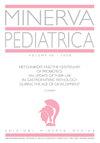窒息或缺氧缺血性脑病的严重程度参数不能解释接受治疗性低温治疗的新生儿中苯巴比妥药代动力学的个体间变异性。
IF 2.6
4区 医学
Q2 Medicine
引用次数: 1
摘要
背景本研究采用群体建模方法来评估和量化窒息和缺氧缺血性脑病(HIE)严重程度对接受治疗性低温治疗的窒息新生儿苯巴比妥药代动力学的影响。方法新生儿接受苯巴比妥(TOBY试验方案)。120份血浆样本来自50名新生儿,中位(IQR)体重3.3(2.8-3.5)kg,胎龄39(39-40)周。数据分析使用NONMEM 7.2®版本。年龄、体重、性别、伴随用药、肾和肝功能标志物以及窒息和HIE的严重程度参数被测试为苯巴比妥药代动力学的潜在协变量。重度窒息定义为动脉脐带血pH≤7.1,Apgar 5≤5,重度HIE定义为振幅积分脑电图(aEEG)正常化时间>24h。重量为1kg时,分配体积为0.91L,每增加1kg,分配体积增加0.91L。清除率为0.00563L/h。苯巴比妥清除率的协变量无统计学意义。结论:无论窒息或HIE的严重程度如何,研究人群中都不需要调整苯巴比妥的剂量。本文章由计算机程序翻译,如有差异,请以英文原文为准。
Severity parameters for asphyxia or hypoxic-ischemic encephalopathy do not explain interindividual variability in the pharmacokinetics of phenobarbital in newborns treated with therapeutic hypothermia.
BACKGROUND
The current study uses a population modeling approach to evaluate and quantify the impact of severity of asphyxia and hypoxic-ischemic encephalopathy (HIE) on the pharmacokinetics of phenobarbital in asphyxiated newborns treated with therapeutic hypothermia.
METHODS
Included newborns received phenobarbital (the TOBY trial protocol). 120 plasma sample were available from 50 newborns, median (IQR) weight 3.3 (2.8-3.5) kg and gestational age 39 (39-40) weeks. NONMEM version 7.2® was used for the data analysis. Age, body weight, sex, concomitant medications, kidney and liver function markers, as well as severity parameters of asphyxia and HIE were tested as potential covariates of pharmacokinetics of phenobarbital. Severe asphyxia was defined as pH of arterial umbilical cord blood ≤7.1 and Apgar 5 ≤5, and severe HIE was defined as time to normalization of amplitude-integrated electroencephalography (aEEG) >24 h.
RESULTS
Weight was found to be the only statistically significant covariate for the volume of distribution. At weight of 1 kg volume of distribution was 0.91 L and for every additional kg it increased in 0.91 L. Clearance was 0.00563 L/h. No covariates were statistically significant for the clearance of phenobarbital.
CONCLUSIONS
Phenobarbital dose adjustments are not indicated in the studied population, irrespective of the severity of asphyxia or HIE.
求助全文
通过发布文献求助,成功后即可免费获取论文全文。
去求助
来源期刊

Minerva pediatrica
PEDIATRICS-
CiteScore
2.70
自引率
3.80%
发文量
1
审稿时长
>12 weeks
期刊介绍:
Minerva Pediatrica publishes scientific papers on pediatrics, neonatology, adolescent medicine, child and adolescent psychiatry and pediatric surgery. Manuscripts may be submitted in the form of editorials, original articles, review articles, special articles, letters to the Editor and guidelines. The journal aims to provide its readers with papers of the highest quality and impact through a process of careful peer review and editorial work.
 求助内容:
求助内容: 应助结果提醒方式:
应助结果提醒方式:


